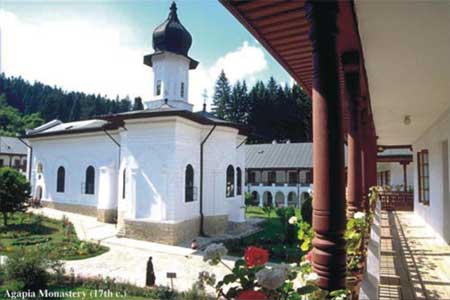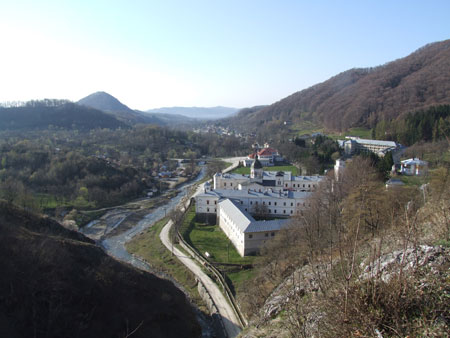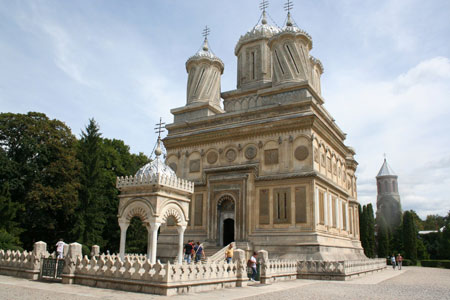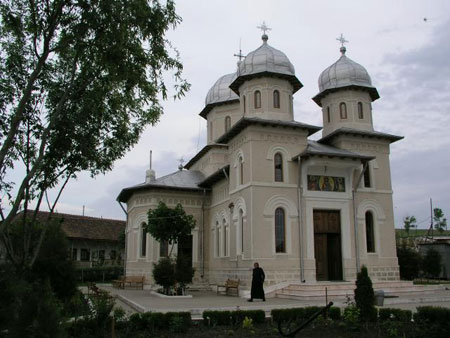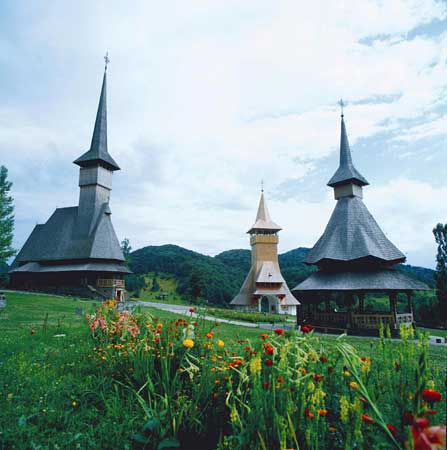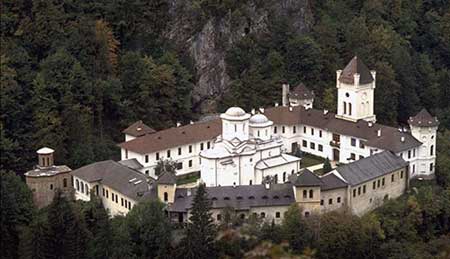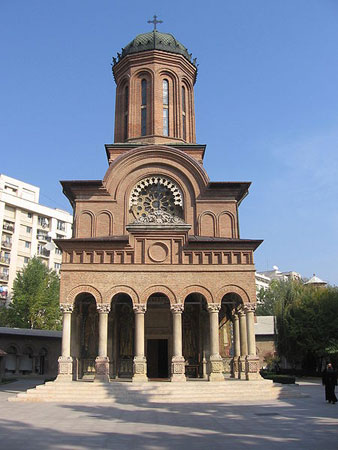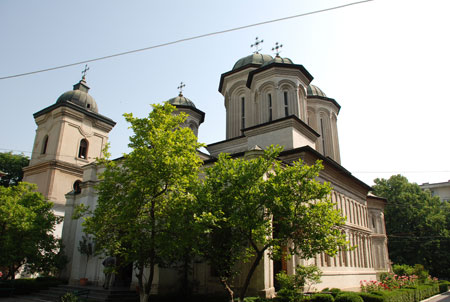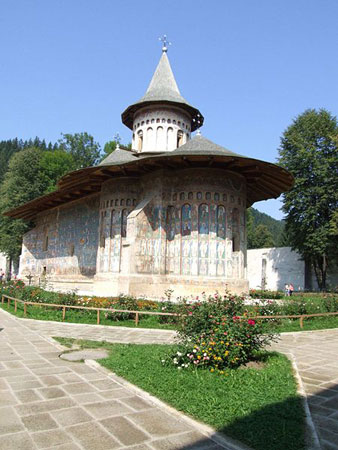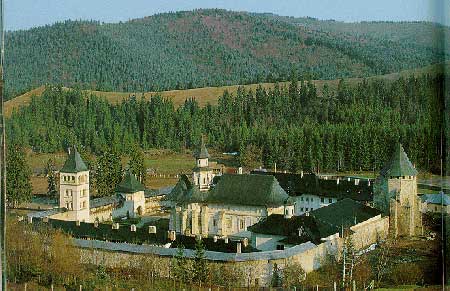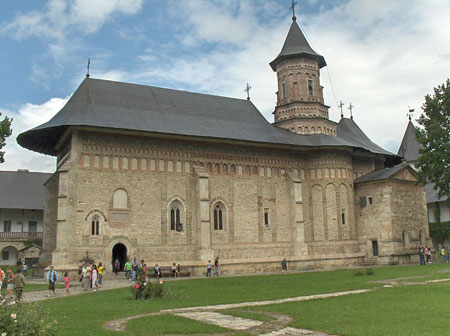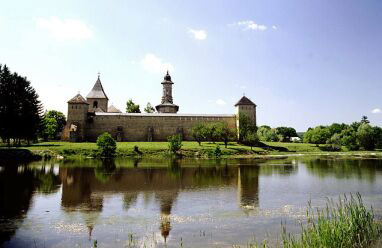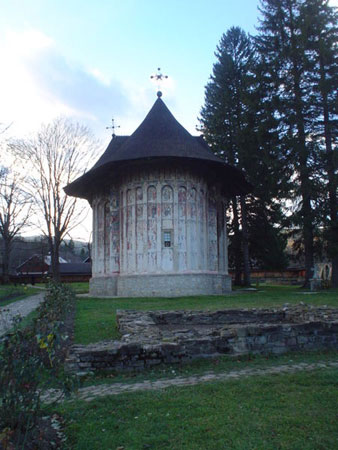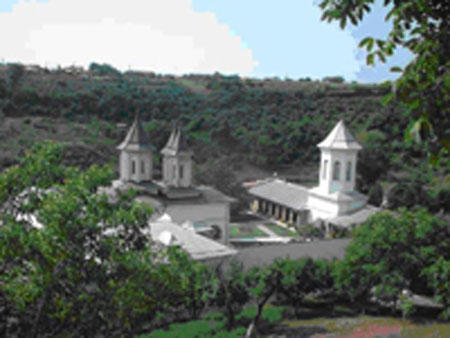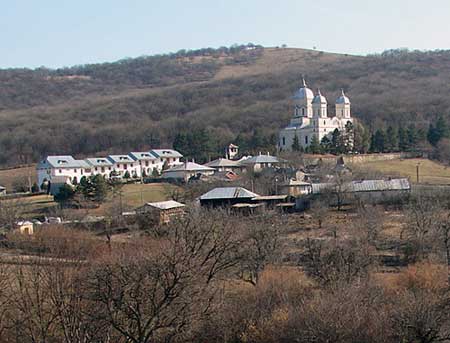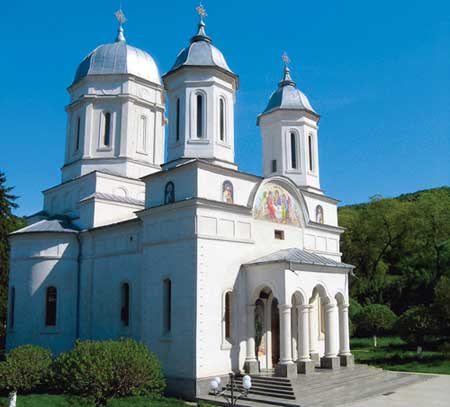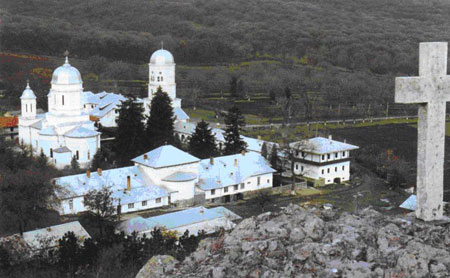Monasteries and Churches in RomaniaIn the 15th-18th centuries, monasteries in Wallachia and Moldavia were generally erected, financed and maintained by enlightened ruling princes, high dignitaries or high clergymen. Monasteries became the main promoters of art and culture, with learned scholars, schools, training centres, libraries, and printing facilities attached to them. Their development was also due to the valuable assets and vast estates, forests, vineyards, lakes etc. that they owned, which were donated by their princely founders, landowners or by wealthy believers. Monasteries in Romania, especially in Moldavia and Wallachia, have been most cherished, and probably are the best preserved cultural sites in the country. One may justly wonder why.
A glimpse on monasticism, its roots and cultural connotations may, to a certain extent, provide answers to the question. Another reason is of a historic nature. Romania was geographically placed at the crossroads between the Eastern and the Western worlds, a rich land encountered and coveted by three empires (Hapsburgs, Ottomans & Russians), and consequentely, ravaged by foreign invasions (mainly of the Turks), for centuries long. In the Middle Ages, Wallachia and Moldavia were under Ottoman suzerainity, meaning that their ruling princes were Romanian, elected by local boyars; the countries were free to deal with their internal affairs as they pleased, but they had to pay an annual tribute to the Ottoman Empire. Monasteries, of which many were fortified (during Stephen the Great's rule in Moldavia, or during Matei Basarab's rule in Wallachia), represented a subterfuge devised by the Romanian princes in order to delude the Ottomans' interdiction to built defence fortresses that could oppose resistance to them. The great number of monasteries and churches may be also related to the Romanians' constraint to hide themselves and their precious assets in safe and hardly accessible places (usually located near the Carpathians and the Subcarpathians) at times of war. The art and historic treasures kept in monasteries are living tokens of the Romanians' need to store and preserve their history and culture at difficult and uncertain times. Likewise, the Romanians' yearning to keep their identity through Christian faith, as a people confronted constantly with the "strings and arrows" of fate, their need for stability and security may account for the great number of churches and monasteries raised all over the country. The fact that religious edifices in Romania are generally better administered and better equipped with brochures, postcards etc. than most other Romanian cultural attractions like museums, archaeological sites, monuments is yet another aspect to be considered. But whatever the arguments related to the religious sites that actually make up the bulk of heritage tourism in Romania, the monasteries that one can see today, which fortunately have escaped the lapse of time and the evils of history, transcend their Orthodox significance, and give an accurate account of the Romanians' spiritual life, artistic wealth, and saga.Agapia Monastery
The history of this monastery starts with the old settlement - Agapia din Deal (Agapia from the hill) - founded, probably, by petru Rares and his wife Elena, between 1527-1538 or 1541-1546. The high place, hardly accessible, were Agapia din deal is located, makes that at the begining of the 17th century all the annexes to be moved on the place that it is today at Agapia din Vale (from the valley). Ruined and again built, burned and remae again, Agapia din Deal become a very charming hermitage. On the place of the churc, built at the begining of the 17th century, hetman Gavril, the brother of Vasile Lupu (Moldavian ruler), and his wife, Liliana, raise at Agapia din Vale, in 1642, the Agapia Monastery.
Agapia, attacked and robed many times, was renoved radicaly during 1858-1862. Is a period in which the great painter Nicolae Grigorescu makes here some masterpieces. The painting of the great maestro, that had not suffer much in the fire from 1903, are an important treasure of the monastery.
The monastery has a museum with an important colection of objects having great historical and artistical value. There old icons from XVI-XVII and XVIII centuries or signed by N. Grigorescu, textures and embroideries, crosses, other religious objects etc. There are also old manuscripts, carpets in Moldavian style made in the monastery workshops.Bistrita Monastery
The Bistrita Monastery (Romanian: Manastirea Bistrita) is a Romanian Orthodox monastery located 8 km west of Piatra Neamt. It was dedicated in 1402 by Romanian Voivode Alexandru cel Bun whose remains are buried here.
The monastery is surrounded by 4 meter high stone walls built during Petru Rares's reign (1541-1546), the original ones being destroyed in 1538 by Suleiman the Magnificent's army. Also from the same period dates a chapel located north of the monastery. The church is historically and archaeologically valuable. It shows features of Byzantine architecture, has many beautiful ornaments, the 15th century entrance door being a work of fine craftsmanship. The bell tower was erected in 1498 by Stephen the Great.
A remarkable item preserved here is the miraculous icon of Saint Anne given as a present to the monastery by Manuel II Palaiologos, emperor of Constantinople.
The monastery was an important cultural center for calligraphers, miniaturists and chroniclers. The monastery's museum hosts an important collection of medieval art.Monastery Brancoveni
The Monastery is situated in the village Brancoveni, at 20 km from Slatina city , the Olt county capital, on DN 54.
Year 1491 seems to be after off-line sources the first certification of the Monastery Brancoveni, three years later being officially certificate.
In order to remind the ancient memory of Matei Basarab, Brancoveanu built outside a structure (1700-1702), that keeps the genuine painted faces of the erectors and of Matei Basarab.
The Monastery Brâncoveni , gilded and restored , starting with 1705 represented an important center of Romanian medieval civilization.
The Monastery Brancoveni was restored since 1985, and in 1998-1999 was built the monastery museum with a rich inventory that completes the old LapidariumCurtea de Arges Monastery
The Cathedral of Curtea de Arges (early 16th century) is one of the most famous buildings in Romania, and stands in the grounds of a monastery, 1 1/2 m north of Curtea de Arges. It is dedicated to Saint Nicholas.
It resembles a very large and elaborate mausoleum, built in Byzantine style, with Moorish arabesques. In shape it is oblong, with a many-sided annex at the back. In the centre rises a dome, fronted by two smaller cupolas, while a secondary dome, broader and loftier than the central one, springs from the annex. Each summit is crowned by an inverted pear-shaped stone, bearing a triple cross, emblematic of the Trinity.
The windows are mere slits; those of the tambours (the cylinders on which the cupolas rest) are curved and slant at an angle of 70 degrees, as though the tambours were leaning to one side. Between the pediment and the cornice a thick corded moulding is carried round the main building. Above this comes a row of circular shields, adorned with intricate arabesques, while bands and wreaths of lilies are everywhere sculptured on the windows, balconies, tambours and cornices, adding lightness to the fabric. It is all raised on a platform 7 ft (2.1 m). high and encircled by a stone balustrade.
Facing the main entrance is a small open shrine, consisting of a cornice and dome upheld by four pillars. The cathedral is faced with pale grey limestone, easily chiselled but hardening on exposure. The interior is of brick, plastered and decorated with frescoes. Close by stands a large royal palace, Moorish in style. The archives of the cathedral were plundered by Hungarians and Turks, but several inscriptions, Greek, Slav and Roman, are left.
One tablet records that the founder was Prince Neagoe Basarab (1512-1521); another that Prince Ioan Radu completed the work in 1526; a third describes the repairs executed in 1681 by Prince Serban Cantacuzino; a fourth, the restoration, in 1804, by Joseph, the first bishop. Between 1875 and 1885 the cathedral was reconstructed, and in 1886 it was reconsecrated.Dervent Monastery
In the proximity of the old fortress of Dervent, on the left bank of the Danube, near Ostrov (96 km South – West of Constanta county), the autochthonous Romanian monks founded a large hermitage in the 9th century under the influence of the ancient monastic settlements.
The hermitage of Dervent and the fortress were destroyed in the 11th century by the petchenegs (1036 ).
Tradition says that St Apostol Andrew came here to preach Christian cult and having a rod in his hand and althought he did not stay here for a long time, as long as he stayed he taught the people how to pray and when he left he did it without his rod, because he was thirsty and he smashed a rock with his rod and water sprung out.
Nowadays the water springs only at one religious holiday called “Healing spring”.
There is also a cross shaped stone that is getting bigger from one year to another.
The place has become a pilgrimage place for the persons in pain and the believers that use to gather around the Holy Healing Crosses.
The church have four patrons: the Pious Parascheva, the Healing Source, the Ascension of the Holly Cross and Saint George.Hurez Monastery
Founded in 1690 by Prince Constantine Brancovan, the monastery of Horezu [Hurez], in Walachia, is a masterpiece of the 'Brancovan' style. It is known for its architectural purity and balance, the richness of its sculptural detail, the treatment of its religious compositions, its votive portraits and its painted decorative works. The school of mural and icon painting established at the monastery in the 18th century was famous throughout the Balkan region.
Maramures Monastery
The whole Maramures region is a living “outdoor museum” famous for its unchanged way of life and for its well-preserved wooden villages and churches. It is perhaps one of the better-known regions of Romania - but still not much travelled.
The Maramures wooden churches are remarkable examples of well-preserved religious architecture that emerged from the Orthodox traditions and Gothic style influences.
Sfana Monastery
Sinaia Monastery
The Sinaia Monastery was founded by Prince Mihai Cantacuzino in 1695 and named after the great Sinai Monastery on Mount Sinai. As of 2005 it is inhabited by 13 Christian Orthodox monks led by hegumen Macarie Bogus. It belongs to the archdiocese of Bucharest.
Slimnic Monastery
Tismana Monastery
Tismana Monastery – also named “the Star of Orthodoxy” – is one of the oldest, the most important, and the most beautiful monasteries in Romania. The word “Tismana” is of Thraco-Dacian origin and means “Place fortified with walls”. The presence in the language of such toponimics derived from the root “tis” – or “dis” – is a strong proof on the Romanian people’s continuity of existence on the territory of Dacia.
The Roman enameled and ordinary bricks one can see in the pavement of the two churches and of the annex buildings as well as those found in the base of a much older church, prove the existence in this place of a Dacian-Roman fortress in earlier times.
After a temporary Hungarian occupation of Severin, St. Nicodim the Wallachian and a group of monks from Vodita Monastery came to Tismana. It was here, on the foundation of an old monastery destroyed by invaders, that he built – with the material support of Voievode Radu I (1377-1383) – the actual church, dedicated to the Dormition of Our Lady. Initially, the church had a monochrome painting (in ochre) of simple, geometric or floral drawings that still can be seen. The church was consecrated in 1387. Patriarch Filotei of Constantinople, who raised it to primate monastery over the other Romanian monasteries around, may have been present at the consecration.
After the town of Severin was partially destroyed, the Metropolitanate, established in 1370, moved its residence to Tismana. The monastery still preserves the oldest Romanian embroideries, such as the epitrachilion and the hypogonation that belonged to metropolytan Antim.
Since both the founder and the metropolitan were living at Tismana Monastery, a conflict arose between them and Nicodim had to leave the monastery he had founded. He went to Prislop, in Silvasul de Sus, a Romanian center in
Hateg Country. There, on the foundation of an old church, he built a new church, the only one monument in Transylvania with a “threecone” design. It was also there that St. Nicodim made copies of “Evangheliarul” – now at the National Museum in Bucharest. After the death of Metropolitan Athanasie of Severin (1404), St. Nicodim returned to Tismana in 1406. On December 26, the same year, he passed away and was buried in the porch of the monastery be had founded. Through the years the church underwent various repairs. Voievode Neagoe Basarab (1512-1521) roofed the church with lead plates. During the reign of Voievode Radu Paisie the fortress out in stone and the narthex doors were added in 1564. In 1564 Nedelcu, great vornic of Voievode Peter the Young (Petru cel Tânar), brought Dobromir, a painter from Târgoviste, who provided the church a polychrome painting that has been preserved in the narthex only.
There is a document that specifies that the great church built by Nicodim was in existence in 1599. It was repaired between 1650-1651, during the rule of Voievode Matei Basarab, when the iconostasis (now at Crasna Skete, in Gorj district) was restored and St. Nicolas church of the hospital was rebuild.
In 1733 and 1766, the painting in the great church was restored with the support of Stanca, wife of the Chancellor Matei Glogoveanu.
In 1821, Tudor Vladimirescu organized at Tismana a center of resistance wherefrom the revolutionaries could get their supplies.
After some repair works done in 1855, the porch of the big church was demolished at the tomb of the Sf. Nicodin the Wallachian, the founder, was left outside. By demolition of the porch the church lost an element most specific to the Romanian architectural style. The monastery will preserve along the centuries the work of the Romanian monks that taught many trades in the monasteries on Mount Athos, especially at Cutlumush Monastery, which was built by Vlaicu Voievode of Walachia.
St. Nicodim’s cultural activity, in S-E of Europe and in Romanian Provinces, changes entirely the opinions regarding a so-called “foreign influence” upon Romanian culture. The Romanian culture is a product of the Romanian ethnical element developed in the monasteries on Mount Athos, were representatives of other nation had been trained too.
Antim Monastery
The Antim Monastery is located in Bucharest, Romania on Mitropolit Antim Ivireanu Street, no. 29. It was built between 1713 and 1715 by Saint Antim Ivireanu, at that time a Metropolitan Bishop of Romania. The buildings were restored by Patriarch Justinian Marina in the 1950s. As of 2005, there are 7 monks living in the Monastery. The monastery also hosts a museum with religious objects and facts about the life of Antim Ivireanu.
Radu Voda Monastery, Bucharest
Voronet monastery
Voronet is a monastery in Romania, located in the town of Gura Humorului, Moldavia. It is one of the famous painted monasteries from southern Bukovina, now in Suceava County. Between May and September 1488, Stephen III of Moldavia (known as "Stephen the Great") built the Voronet Monastery to commemorate the victory at Battle of Vaslui. Often known as the "Sistine Chapel of the East", the frescoes at Voronet feature an intense shade of blue known in Romania as "Voronet blue". "[T]he exterior walls — including a representation of the Last Judgment on the west wall — were painted in 1547 with a background of vivid cerulean blue. This blue is so vibrant that art historians refer to Voronet blue the same way they do Titian red."
Putna monastery
The Putna monastery (Romanian: Manastirea Putna) is a Romanian Orthodox monastery, one of the most important cultural, religious and artistic centers established in medieval Moldavia; as with many others, it was built and dedicated by Prince Stephen the Great. Putna was founded on the lands perambulated by the Putna (which has its source in the Obcina Mare mountains, Bukovina). Stephen the Great is famous for building and influencing the building of dozens of churches and monasteries all over Moldavia (allegedly, he founded a religious edifice after each important military victory). The Putna Monastery houses the tombs of Stephen —nowadays, a place of pilgrimage —, and several of his family members. The icon veils and tombstones are held as fine examples of Moldavian art in Stephen the Great’s time.
Right after Stephen the Great won the battle in which he conquered the Kilia citadel, he began work on the monastery as a means to give thanks to God, on July 10, 1466 - the church was to be dedicated to the Virgin Mary. The terrain on which the monastery is built is believed to have been previously occupied by a fortress. A chronicle of the time mentions that Stephen bought the Vicovu de Sus village in exchange for 200 zlots, and awarded the land and revenue to the treasury of the monastery.
Putna was completed in three years, but was consecrated only after four more years passed, given that the Moldavians engaged in other battles. On September 3, 1470, during a ceremony attended by Stephen and all his family, the monastery was consecrated, and subsequently became the most important religious site in the area.
Sucevita monastery
Sucevita is the largest and also the last built of the painted monasteries of Bucovina. It was built in 1581 by the Bishop of Radauti, Gheorghe Movila. It is situated in the village of the same name in the foothills of the Carpathians west of Radauti. Like all the painted monasteries, the church, dedicated to the Dormition of the Theotokos, is frescoed inside and out. The monastery is surrounded by thick, fortified walls built by the Voievod Ieremiah Movila, brother of Bishop Gheorghe. Both the Movila brothers are buried at the monastery.
Neamt monastery
The Neamt Monastery (Romanian: Manastirea Neamt) is a Romanian Orthodox one religious settlement, one of the oldest and most important of its kind in Romania. It was built in 14th century, and it is an example of medieval Moldavian architecture. Jewel of 15th century architecture, the church was built by Stefan cel Mare and finished in the year when the Moldavian army won the battle against King John Albert (1497).
The monastery is located in north-eastern part of Romania, in Neamt County, 10 km west of Târgu Neamt. It is accessible by car (DN 15B road) and train (Târgu Neamt railway station); the nearest airport is Suceava, located about 60 km north.
Sumptuous, with delicate colour effects, the monastery shows the maturity of the Moldavian architectonic style, which matured during Stefan cel Mare's period. The façade of the church is covered with the decoration characteristic of Stefan cel Mare's time: Gothic windows and friezes with enamelled disks, coloured in green, yellow and brown.
In the chamber of the tombs, which appear for the first time at this church, is the tomb of Stefan al II-lea, son of Alexandru cel Bun and uncle of Stefan cel Mare.
The art treasures kept at Neamt Monastery are proof of the intense artistic and cultural activity which took place here through the centuries. Here Gavril Uric showed his talent, the most important representative of the Moldavian miniature from the 15th century. His first known manuscript, dated 1429, is kept in the Bodleian Library at Oxford (UK). The calligraphers and miniaturists of Stefan cel Mare who worked at this important center made many of the books given to Putna Monastery. In the cells of the monastery, the chronicler Macarie wrote the chronicle of Petru Rares's rule, and Eftimie the chronicle of Alexandru Lapusneanu's rule.
The learned tradition of the Neamt Monastery disappeared in the 17th and 18th centuries, to be reborn at the beginning of next century, when Metropolitan Veniamin Costachi established a printing house here. In the monastery museum is the old printing press, which was used to print books since 1807. In the monastery is a famous library more than 600 years old. Among the almost 11,000 volumes are many rare books, some being the first ones printed in this country. The altar screen of the former church from Neamt Fortress, is the most important treasure of all those in the monastery, along with the icon painted by Nicolae Grigorescu "The Flight from Egypt".
Moldovita monastery
The Moldovita Monastery (Romanian: Mânastirea Moldovita) is a Romanian Orthodox monastery situated in the town of Moldovita, Suceava County, Moldavia, Romania. The Monastery of Moldovita was built in 1532 by Petru Rares, who was Stefan the Great's illegitimate son. It was founded as a protective barrier against the Muslim Ottoman conquerors from the East.
Stephen the Great, the King of Romania from 1457 until his death in 1504, fought 36 battles against the Ottoman Empire, winning 34 of them. He was very religious and built churches after many victories. Stephen's illegitimate son, Petru Rares, who ruled Romania from 1527-1538 and again from 1541-1546, promoted a new vision for Bukovina churches. He commissioned artists to cover the interiors and exteriors with elaborate frescoes (portraits of saints and prophets, scenes from the life of Jesus).
The best preserved are the monasteries in the towns of Sucevita, Moldovita, Voronet, Humor, Suceava, Patrauti, and Probota. Seven of them--including the Monastery of Moldovita--were placed on UNESCO World Heritage list in 1993.
Dragomirna Monastery
The Dragomirna Monastery was built during the first three decades of the 17th century, 15 km from Suceava, in Mitocu Dragomirnei commune. It is the tallest medieval monastery in Bucovina and renowned in Orthodox architecture for its unique proportions and intricate details, mostly carved into stone. It lies among forested hills of fir and oak. The history of the monastery started in 1602, when the small church in the graveyard was built and dedicated to Saints Enoch, Elijah and John the Theologian. In 1609 the dedication of the larger church was made to the "Descent of the Holy Spirit".
Unlike other monasteries, there is no votive inscription at Dragomirna. The year in which it was built and the names of the founders were discovered only after study of the documents of the time. The founders were the same as for the small church in the graveyard, the scholar, artist and Metropolitan Anastasie Crimca; the high chancellor Lupu Stroici; and his brother the treasurer Simion Stroici. Born in Suceava as the son of merchant Ioan Crimca and of the princess Carstina, Anastasie Crimca became a monk at the Putna monastery when he was young. There Crimca built his reputation as a prelate, patriot, and scholar and, above all, as an artist, which was expressed through his whole life. He asccended to the highest ranks in the Orthodox Church and became, in 1608, the Metropolitan of Moldavia. During the summer of 1600, he took the oath of faith to Michael the Brave (also known as 'Mihai Viteazu), who entered the princely seat of Moldavia without fighting and succeeded in joining together the three Romanian lands for the first time.
According to the inscription above the bell tower, in 1627 during the rule of Miron Barnovschi, because of the frequent invasions by the Turks and Tatars, the monastery was endowed by the prince with a defensive wall, which made it look like a fortress. In the four corners there are narrow square towers. On the western and northern sides are the cells, built between 1843 and 1846. They were part of the general reconstruction. Inside the precincts, on the right side of the entrance is the vaulted refectory, built in the Gothic style. It now holds the Dragomirna museum of ancient art. The large church's plan is a much-elongated rectangle, without side apses. It seems to be built up to defy the heights, to seek the light; it symbolized prayer soaring from the bottom of one's heart towards the holy sky.
Humor Monastery
Humor Monastery located about 5 km north of the town of Gura Humorului, Romania. It is a monastery for nuns dedicated to the Dormition of Virgin Mary, or Theotokos. It was constructed in 1530 by Voievod Petru Rares and his chancellor Teodor Bubuiog. The monastery was built over the foundation of a previous monastery that dated from around 1415. The Humor monastery was closed in 1786 and was not reopened until 1990.
Monastery Clocociov
Placed in the southern part of the town Slatina, in a depression with a picturesque landscape and a panorama of river Olt – the monastery Clocociov lies from centuries in this region.
An important restoration from the past of the monument took place during the time of Matei Basarab, and it is attested in documents and also it is written on the monastery wall, near the entrance.
In 1862 the monastery was repainted, this work being certificate in an inscription, from 1934, inside the monastery, above pronaos door. The inscription certified that the church was repainted during the time of his holiness, the abbot Atanasie at 23 July 1862”. Today, in this place there is a county warehouse for different goods of cultural patrimony and a museum of medieval civilization.
Monastery Calui
The monastery Calui, began to be built, as the old documents attests, "during the days of Basarab Voda Neagoe", by Vlad Banul Dumitru parcalabul and Balica the sword bearer. The brothers Buzesti continued the building initiated by the first erectors.
The refined and attentive observer Paul de Alep, a Syrian traveller was very much impressed by the monastery Calui and he wished to be sacred to Antiohia.
The Celic Dere Monastery
The Celic Dere Monastery is situated in Frecatei Commune, in Tulcea County and is one of the most well known monasteries in Dobrogea, considered the center of Orthodoxism of the area.
It is named after the nearby river, which translated from Turkish means “River of Steel”. According to the existing documents, the first church was built here at the beginning of the 19th century by the bishop Athanasie Lisivencof. Today, a cemetery can be found on this land. The people that built the church were priests from Transylvania and Basarabia, who had lived on the Athos Mountain, in Greece.
The little church burnt around the 1840s, the sultan Abdul-Medgid (1839-1861) from Constantinople approved to the building of a new church. Thus, in 1846, the first church was built, with “The Assumption of the Holy Virgin” as its dedication day and a chapel with “The Holy Archangels Michael and Gabriel” as its dedication day.
After a short time, the monks were moved to Saon, where they built another monastery. At Celic Dere the monks were replaced by nuns. In time, the hierarchs of Lower Danube supported the efforts of the nuns and thus, in 1901 the bishop Partenie Clinceni started to build the monumental church with semi-basement. For some time this served as a winter chapel. The construction, whose architect was Toma Dobrescu, was only completed in 1932, and was dedicated on the 22nd of October of the same year. The interior was painted by Gheorghe Eftimiu, and the altar screen covered in gold, was done by Ion Dinea.
During the next years, a studio for religious painting, a primary school for adults under the age of 40, a workshop for rugs and traditional sewing, were founded under the care of bishop Nifon.
The Monastery of Cocos
The Monastery of Cocos – is situated at 8 km from the village of Niculitel, at the foot of Cocosu Hill. The first monahal settlement was build in 1833 by the Transylvanian monks that returned from Athos Holly Mount: Visarion (former monk at the Monastery of Neamt), Gherontie and Isaiia.
At the beginning of the 19th cen., both the church and the inside pavilions were refurbished according to the plans of architect Toma Radulescu.
The church painting is the work of italian artist F. De Biasse and of local iconographer Geo Cardas (who painted the porch). The Monastery museum has an important religious book collectin, gathered from all the parishes of Tulcea county.
Saon Monastery
Saon Monastery, a nuns monastery, was founded in 1864 as a small nuns complex of the Celic Dere monastery. It became autonomous starting with 1881.
The monastery comprises: the church, the chapel, the nuns cells and a windmill. The church , dedicated to the, Ascension of God “ was built in 1912. The Bishop Nifon of the Lower Danube put the foundation stone.
